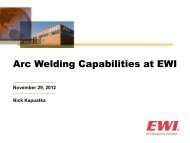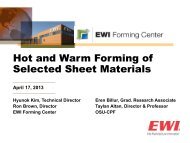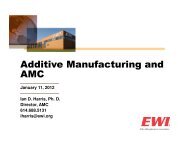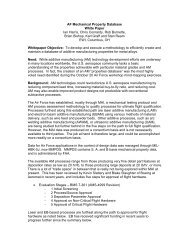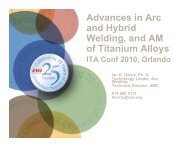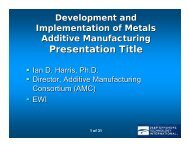Advances in Solid-State Joining at EWI
Advances in Solid-State Joining at EWI
Advances in Solid-State Joining at EWI
Create successful ePaper yourself
Turn your PDF publications into a flip-book with our unique Google optimized e-Paper software.
L<strong>in</strong>ear Friction Weld<strong>in</strong>g<br />
<br />
<br />
<br />
New technology<br />
─ Concepts derived from direct-drive<br />
friction weld<strong>in</strong>g<br />
─ Young technology, developed only ~15<br />
years ago<br />
─ Modern systems largely hydraulically<br />
based<br />
Process <strong>in</strong>puts<br />
─ Normal force<br />
─ Transl<strong>at</strong>ional frequency<br />
─ Transl<strong>at</strong>ional displacement<br />
─ Deceler<strong>at</strong>ion sequence for align<strong>in</strong>g parts<br />
Advantages<br />
─ High deform<strong>at</strong>ions (~10s of thousands<br />
of percent) along bond l<strong>in</strong>e<br />
─ Weld morphologies similar to other<br />
friction welds<br />
─ Rapid (seconds) cycle times<br />
L<strong>in</strong>ear friction weld<strong>in</strong>g system (Courtesy Thompson<br />
Friction Weld<strong>in</strong>g Mach<strong>in</strong>es)<br />
Schem<strong>at</strong>ic Diagram of the l<strong>in</strong>ear friction weld<strong>in</strong>g<br />
process (Courtesy APCI Inc.)




